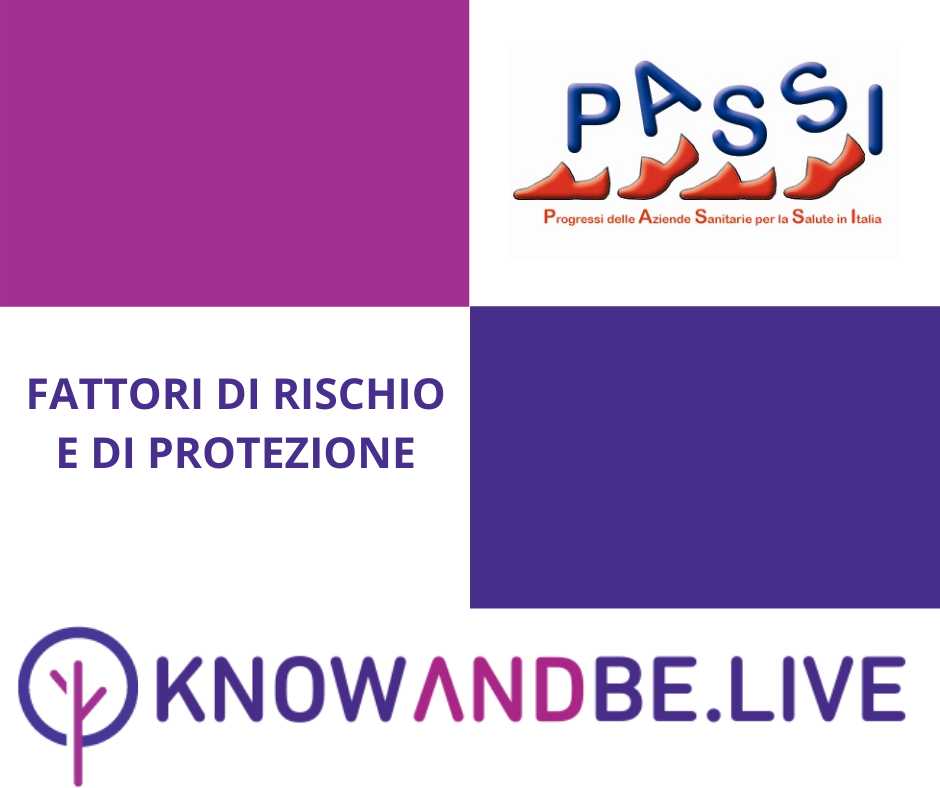Behavioral risk factors: Italians and the lifestyle
The PASSI survey data has been updated

October 8th, 2020
A substantial share of cancers
is attributable to lifestyle habits, such as smoking, alcohol consumption,
sedentariness, unbalanced diet.
150 thousand diagnoses could be
avoided in Italy every year, maintaining a healthy lifestyle.
The data on the major risk factors related to the cancer onset collected by the
PASSI and PASSI d’Argento surveillance system are set out below.
Smoking habit

1 in 4 people in Italy smokes and 1 in 6 people is a former
smoker. Smoke is generally more prevalent among men between 25 and 34 years
old, belonging to the lowest social classes or with socio-economic issues.
The 5% reduction in smoking rates in the last decade is significant from North
to South, both among men and women.
The smoking habit in girls between the ages of 18 and 24 years in Northern
Italy remains stationary.
Healthcare
professionals do not seem attentive enough to this problem, only 1 in 2 smokers
received the advice to quit smoking.
Alcohol consumption

1 in 6 people in Italy consumes alcohol at greater risk for health.
The consumers share is high among men between 18 and 24 years old and among
socially advantaged or highly educated people. Excessive consumption remains a
prerogative of residents in Northern Italy, particularly in the North East.
Attention from health care professionals is low, only 6.4% of higher risk
consumers have received the advice to drink less.
18% of the over-65s diagnosed with cancer consume high levels of alcohol. Only
12% of these have been advised by a healthcare professional to be careful about
the amount of alcohol they consume.
Sedentary lifestyle

Even though physical
activity is able to reduce the risks related to the onset and progression of
diseases such as type 2 diabetes mellitus, cardiovascular diseases, stroke and
several types of cancer, 35% of people in Italy are sedentary.
Lack of physical activity is more frequent as we age, among women, and among
those with lower socioeconomic status or education. The amount of sedentary
people is increasing especially in southern regions.
Again, attention from health care professionals is low.
Only 30 % of respondents report being advised to engage in physical activity. This
share does not reach 40% among overweight people and 45% among people with
chronic diseases.
Fruit and vegetable consumption

Good nutrition is one of the fundamental elements to avoid the onset of many pathological conditions, such as cancer and cardiovascular diseases, and to control the evolution of pre-existing diseases.
The World Health Organization recommends a minimum of 15 ounces of fruit and vegetables per day, corresponding to five servings of 3 ounces.
Only 10% of Italians consume the recommended amount of fruits and vegetables. Consumption increases with age; it is slightly more frequent in women, in people without economic difficulties and among people with a university degree, but it is lower in Southern Italy.
Excess weight
Excess weight is a condition characterized by excessive accumulation of body fat. More than 40% of adults in Italy are overweight, 10.9% suffer from obesity.
Excess weight affects 56% of adults between the ages of 50 and 69 years old. It is more frequent among men, although the proportion of obese is similar between the two genders, among people with social disadvantage and in Southern Italy.
Even though the problem is obvious, the attention of health care professionals is very low, less than half of the overweight respondents have been advised to lose weight.
Source: The numbers of cancer in Italy 2020 (for citizens and patients)
--------------------------------------------------------------------------------
PASSI, Progress of Authorities for Healthcare in Italy, has been collecting information on health and behavioral risk factors since 2008. PASSI d’Argento collects information on health and behavioral risk factors in the population over age 65, diagnosed with cancer, other chronic diseases or chronic-free conditions.
Higher-risk drinking is defined as alcohol intake in one of these three ways: high habitual drinking (more than 3 average daily units of alcohol for men and 2 for women), excessive episodic drinking (more than 5 units of alcohol on a single occasion for men and 4 for women), or drinking outside a meal. One alcoholic unit is the amount of ethanol contained in a can of beer, a glass of wine, or a shot of liquor.
In PASSI, people are split into physically active (who engage in 30 minutes of moderate physical activity at least 5 days a week), partially active (who do not do heavy work but engage physical activity in leisure time, not reaching the levels described above), or sedentary (who do not engage in any physical activity, nor do they do heavy work).
The excess weight is calculated through the body mass index (BMI) defined by the ratio between body weight expressed in kilograms and height expressed in meters, raised to the square (Kg/m2). An overweight person has a BMI between 25 and 30, an obese person above 30.
